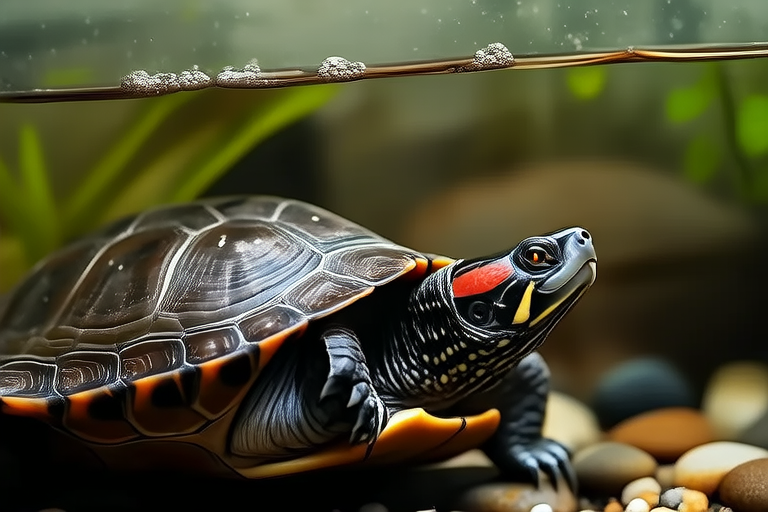Top 10 Myths About Red-eared Slider Care You Need to Know
Red-eared sliders (Trachemys scripta elegans) are among the most popular semi-aquatic turtles kept as pets. These charismatic creatures, known for their distinctive red markings behind the eyes, are native to the southern United States and northern Mexico. Despite their popularity, many myths persist regarding their care, which can lead to improper husbandry and potential health issues for these turtles. This article aims to dispel ten common myths about red-eared slider care, providing you with the knowledge necessary to ensure your turtle’s well-being.
Myth 1: Red-eared Sliders Can Thrive in Small Tanks
Fact: One of the most pervasive myths is that red-eared sliders can live comfortably in small tanks. In reality, these turtles require ample space to swim, bask, and move around. A general rule of thumb is to provide at least 10 gallons of water per inch of shell length for juvenile turtles, increasing this ratio as they grow. An adult red-eared slider may need a tank of over 100 gallons. Insufficient space can lead to stress, poor health, and stunted growth.
Myth 2: Tap Water Is Safe for Your Turtle’s Habitat
Fact: Using tap water directly in a turtle habitat is not advisable due to the presence of chlorine and other chemicals harmful to turtles. Instead, it’s recommended to use dechlorinated water, which can be achieved through water conditioners or by letting tap water sit for 24 hours before adding it to the tank. Additionally, maintaining appropriate pH levels and water hardness is crucial for the turtle’s health.
Myth 3: Red-eared Sliders Don’t Need UVB Lighting
Fact: UVB lighting is essential for red-eared sliders to synthesize vitamin D3, which helps them absorb calcium. Without adequate UVB exposure, turtles can develop metabolic bone disease, leading to deformities and weakened bones. Turtles should have access to UVB light for 10-12 hours daily, provided by a high-quality UVB lamp designed for reptiles.
Myth 4: Feeding Bread or Dog Food Is Okay for Red-eared Sliders
Fact: While some pet stores might suggest feeding bread or dog food, these items are not suitable for red-eared sliders. Their diet should consist primarily of commercial turtle pellets, supplemented with fresh vegetables like leafy greens and occasional protein sources such as earthworms or feeder fish. A balanced diet ensures optimal nutrition and supports healthy growth.
Myth 5: Red-eared Sliders Hibernate Naturally in Captivity
Fact: In the wild, red-eared sliders hibernate during colder months, but this is not necessary in captivity. Keeping a stable temperature and avoiding fluctuations in the environment is more beneficial for the turtle’s health. If you notice signs of lethargy or reduced appetite, consult a veterinarian rather than allowing the turtle to enter hibernation.
Myth 6: You Can Handle Your Turtle Frequently Without Harm
Fact: While it’s tempting to interact with your pet, excessive handling can cause stress and disrupt the turtle’s natural behaviors. It’s best to limit handling sessions and always support the turtle’s body fully when holding it. Additionally, wash your hands thoroughly before and after handling to prevent the spread of bacteria.
Myth 7: Red-eared Sliders Can Live on a Diet of Fish Alone
Fact: Feeding red-eared sliders exclusively on fish can lead to nutritional deficiencies. A varied diet rich in vegetables, fruits, and appropriate protein sources is crucial. Over-reliance on fish can result in obesity and malnutrition, affecting the turtle’s overall health and lifespan.
Myth 8: Basking Under a Heat Lamp Is Enough for Red-eared Sliders
Fact: While heat lamps are important for basking, they do not provide the full spectrum of light required for red-eared sliders. A combination of UVB lighting and a heat source is necessary to mimic natural sunlight. The basking area should reach temperatures between 85-90°F (29-32°C), while the water temperature should be maintained at 75-80°F (24-27°C).
Myth 9: Red-eared Sliders Can Share a Tank with Other Species
Fact: Housing different species of turtles together is generally not recommended. Each species has unique requirements, and mixing them can lead to competition for resources, stress, and even aggression. Keeping red-eared sliders alone or with others of the same species ensures they receive the appropriate care and attention.
Myth 10: Red-eared Sliders Are Low-Maintenance Pets
Fact: Contrary to popular belief, red-eared sliders require consistent care and attention. Regular cleaning of the tank, monitoring water quality, and ensuring proper nutrition are all part of responsible ownership. Neglecting these aspects can result in health problems for the turtle. Investing time in understanding their needs will reward you with a long-lived and healthy pet.
Tips for Proper Slider Care
- Proper Housing: Provide a spacious tank with both aquatic and terrestrial areas. Use appropriate substrates and decorations that promote natural behaviors.
- Dietary Needs: Feed a balanced diet including commercial pellets, fresh vegetables, and occasional proteins. Avoid overfeeding and monitor weight changes.
- Health Monitoring: Regularly check for signs of illness such as lethargy, loss of appetite, or abnormal behavior. Consult a veterinarian if you notice any issues.
- Environmental Control: Maintain correct temperature gradients and water quality to replicate the turtle’s natural habitat.
Resources for Further Learning
To deepen your knowledge about red-eared sliders, consider reading books and articles written by experts in herpetology. Joining online forums and local reptile clubs can also provide valuable insights and support from fellow enthusiasts. Remember, continuous learning is key to becoming a responsible and informed pet owner.
